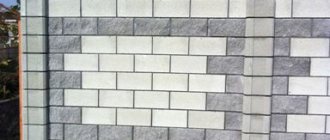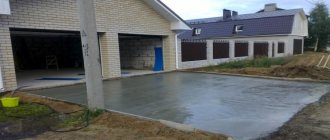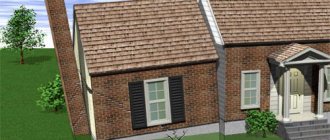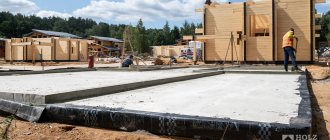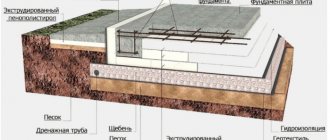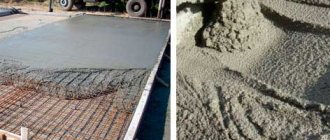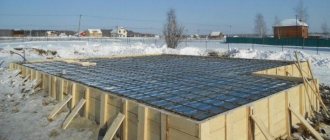Among shallow foundations, the slab foundation is considered the most durable and reliable. Another advantage is the relatively small volume of excavation work, but this is a common feature of all foundations with shallow burial in the ground. The only drawback is the high cost of materials and work, which is due to the large volume of concreting and the need to create a reinforcement frame over the entire base area. But in principle, it is no more expensive than a buried strip foundation, especially if you also take into account concrete floors on the ground of the basement.
A slab foundation allows you to build a house on sand Source kamtehnopark.ru
Scope and calculation features
The main purpose is to use it as a foundation on soft soils with a maximum load-bearing capacity of up to 2.5 kg/cm2. This includes sands - silty and medium density, clays and plastic loams, peat and moist soils. Moreover, it is the level of soil moisture that largely determines its load-bearing capacity - when wet, it literally “floats”, losing its strength properties. Therefore, drainage, waterproofing and blind areas play an important role in the arrangement of this type of foundation.
Reliable waterproofing is an important component of any foundation Source olestnicah.ru
One of the advantages is often given the argument that you can make a monolithic slab with your own hands. But even if we do not consider the issues of choosing the type of concrete and the parameters of the reinforcement frame, such an important stage remains as calculating the dimensions of the slab. And if there is a certain clarity with the area (the size of the house plus a small margin on each side), then the thickness of the slab is not easy to calculate.
The recommended range of foundation slab thickness for low-rise construction is 10-40 cm.
But this range also includes “light construction” in the form of a garage or summer kitchen, and a two-story house with an attic. If you make the slab not “thick” enough or choose the wrong thickness of the reinforcing rod (or cell size), then it will not be able to withstand the total load. An excessive margin of safety leads to an increase in the cost of an already expensive foundation, and an excessive amount of concreting will make the entire structure heavier, and the soil may not be able to withstand the total load.
There is another option with a diametrically opposite scope of application - the slab is installed on rocky and coarse soils with very high load-bearing properties. In this case, it rather levels the construction site rather than redistributing the load from the structure.
Another feature of this foundation is that the laying of pipelines must be done at the stage of the zero cycle Source xpcenter.ru
How to pour a monolithic foundation slab - technology for pouring a concrete base
Pouring a foundation slab is a responsible process that is carried out in accordance with technology requirements.
Technology for pouring concrete base
The algorithm for constructing a slab-type reinforced concrete foundation involves the following stages:
- Preparatory activities. They are carried out before the start of construction work and include geodetic surveys, calculations, project development, and determination of the need for building materials.
- Excavation. They are carried out using special equipment after clearing the construction site of debris, roots and vegetation. The technology involves leveling the surface and marking.
- Construction of a damping cushion. The backfill is made using a mixture of sand and gravel. The materials are evenly distributed over the surface of the future foundation and thoroughly compacted.
- Installation of formwork elements. To make the formwork structure, moisture-resistant plywood, metal sheets or planed boards are used, which are installed along the contour of the foundation.
- Assembly and installation of reinforcement cage. Pre-cut reinforcing bars are connected with tying wire into a strength lattice and installed inside the formwork.
- Preparation of concrete solution and pouring the working mixture into the formwork. It is important to correctly calculate the volume of concrete mixture to perform concreting in one step.
Let us dwell on the features of performing the main stages.
Construction of a slab foundation - calculation of materials and design
The pouring of the monolithic slab is carried out after completion of the preparatory work, which includes the following operations:
- Study of the nature of the soil.
- Determination of groundwater depth.
- Calculation of the load characteristics of the base.
- Development of project documentation.
- Determining the required amount of materials.
After completing the preparatory work, the monolithic slab is poured.
Knowing the overall dimensions of the foundation slab, it is easy to determine its volume and calculate the need for materials. To calculate the amount of reinforcement, you should be guided by the design documentation.
Preparing the site for a reinforced concrete foundation
When performing excavation work, follow the following procedure:
- Remove debris from the site.
- Remove the vegetation along with the root system.
- Level the surface of the site.
- Mark the outline of the future foundation.
- Excavate soil for a shallow foundation.
- Plan the surface of the bottom of the pit.
All that remains is to lay geotextiles and install drainage lines.
How to form a cushion for a monolithic foundation
The foundation slab is poured onto a previously prepared surface. To arrange the pillow, do the following:
- Mix the gravel and sand thoroughly.
- Distribute the mixture evenly over the foundation area.
- Compact the bedding, adding water as you compact.
To get a solid foundation for a future building, figure out how to pour a slab under the foundation.
Constructing formwork for a slab foundation on your own
Carrying out the formwork installation work yourself does not cause any difficulties. Procedure:
A foundation slab is poured onto a previously prepared surface.
- Prepare materials, cut blanks for formwork.
- Assemble panel elements with a height corresponding to the thickness of the slab.
- Install formwork panels around the perimeter of the slab foundation.
It is important to ensure the immobility of the formwork structure by installing supports on the outside. When performing work, pay attention to the tightness of the formwork contour.
How to assemble a load-bearing frame and lay reinforcement
Carry out the activities for assembling the power grid according to the following algorithm:
- Cut blanks of the required sizes from reinforcing steel.
- Lay the longitudinal rods of the lower tier in increments of 20-25 cm.
- Connect them with tying wire with cross members.
- Secure the vertical bars of the corrugated reinforcement.
- Assemble the reinforcement mesh of the upper tier.
- Secure the assembled grid with annealed wire.
- Place the reinforcement cage on special supports.
Place the reinforcement grid in the formwork after laying the waterproofing material.
How to pour a slab under a monolithic foundation
When constructing a slab foundation, you should figure out how to fill it in compliance with the technology. It is important to first determine the required volume of concrete mixture and choose a method for making the solution.
Possible options:
- the use of ready-made mixtures delivered to the work site in mixers. Concrete is transported along a chute and distributed inside the formwork by auxiliary workers;
- independent preparation of the solution using an electric concrete mixer. The limited capacity of the container significantly increases the cycle time;
- using a powerful concrete pump. Special equipment with a sliding rod allows the solution to be supplied through a concrete pipeline, which speeds up the concreting process.
Pouring a slab under a monolithic foundation.
Procedure for concreting:
- Fill the formwork with the prepared solution.
- Spread the concrete evenly.
- Level the surface.
- Compact the concrete mass thoroughly.
Professional builders will always tell you how to pour a monolithic foundation slab.
How to make your own concrete mix
Self-pouring a concrete slab requires the mandatory use of the following components:
- cement, which acts as a binder;
- sand and gravel used as filler;
- water added to the desired plasticity of the solution.
The optimal ratio of these bulk components is 1:3:5. To prepare concrete, mix the ingredients evenly, gradually adding water until the mixture becomes creamy.
How to properly pour a slab foundation under a house
It is not enough to simply prepare concrete and fill the formwork with it. It is important to understand how to properly pour a slab under a house.
Follow these guidelines for pouring concrete:
- do not allow interruptions in the supply of solution;
- compact the concrete with a deep or surface vibrator;
- maintain constant humidity of the array by periodically moistening;
- Lay polyethylene on the poured foundation to retain moisture.
Remember that the process of concrete hardening until it reaches working strength lasts 28 days.
What is taken into account when calculating the foundation
When calculating a monolithic slab foundation, the total load is taken into account, which includes:
- weight of the building, including finishing materials;
- the weight of the plate itself;
- engineering systems equipment;
- communications;
- furniture and household appliances;
- wind and snow pressure.
Atmospheric loads are temporary, but they are taken into account as permanent. They are defined as statistical characteristics given for each region in the tables of regulatory documents. They cannot be neglected - in some areas, wind loads and snow pressure are large, and in terms of per square meter of the foundation they are comparable to the specific gravity of equipment, household appliances and furniture.
Such a layer of snow is a serious test for any home Source bgderab.ru
“Amateur” developers use a simpler method of calculating slab thickness. He proceeds from the position that a low-rise building requires a reinforcing frame made of double mesh. The distances from the bottom and top surfaces of the slab to the reinforcement are taken to be 50 mm, the distance between the chords is more than 70 mm, the rod diameter is in the range of 12-16 mm. And the calculation formula comes down to the following amount: 2x50+70+4x(12-16)=218-234 mm. And since the thickness is rounded up in multiples of 50 mm, it turns out that it is equal to 250 mm. The bearing capacity of the foundation is finally “regulated” by choosing the diameter of the reinforcement and the grade of concrete.
But it must be emphasized once again that this is a very approximate method, and in some cases it may not “work”, so all calculations must be carried out by specialists.
Turnkey construction price
Average market prices for slab reinforced concrete foundations (construction on a turnkey basis) are reflected in the table . The given values are indicative, because the final cost in each specific case must be calculated separately by a specialist.
| Height of the foundation slab, m | Cost of turnkey installation, rub./m3 |
| 0,20 | 4000–4200 |
| 0,25 | 4100–4500 |
| 0,30 | 4400–4800 |
| 0,35 | 4900–5100 |
| 0,40 | 5500–5700 |
Prices for monolithic slabs for foundation construction are presented in the table:
| Plate length, mm | Slab width, mm | Slab height, mm | Slab price, rub. |
| 2010 | 2010 | 200 | 12500 |
| 2010 | 1500 | 200 | 9300 |
| 1500 | 1500 | 200 | 7000 |
| 1900 | 500 | 200 | 2500 |
Types of slab foundation
There are two types of slab foundations based on execution technology: prefabricated and monolithic.
In the first case, reinforced concrete slabs are laid on the prepared site. And as a leveling and “binding” layer, a cement-sand screed is poured. The load-bearing capacity of such a foundation is low, so it is either built on rocky (or coarse-clastic) soils or for light buildings.
A monolithic slab does not have any disadvantages or limitations in use, except for the high cost of manufacturing. There are even recommendations for using deep slab foundations:
- for heavy structures on bulk soils with deepening to continental soil;
- construction on mixed soils with different load-bearing properties;
- for arranging a basement in conditions of high groundwater levels.
According to the profile, there are three foundation options:
- Solid slab. A house without a base, when the surface of the slab serves as the subfloor of the first floor (for example, a Swedish stove). It can be either monolithic or prefabricated.
- Ribbed plate. There are stiffening ribs in the lower part. If this is a monolithic technology, then additional trenches are dug for them, and the formwork and reinforcement are combined with the common part. If this is a prefabricated technology, then ribbed ready-made slabs are used for the foundation.
Additional stiffening ribs will make the structure more reliable even with a small thickness of the main part of the foundation Source vamnapolzu.ru
- Box foundation. A house with a base on a slab and a concrete floor on the first floor. The slab and plinth can have monolithic, prefabricated or combined technology.
Ribbon
A strip foundation is a buried reinforced concrete structure that is laid under the external and load-bearing walls of a building. The width, height and depth of depth may vary. The strength, stability and reliability of the foundation depend on these indicators.
Advantages and disadvantages
The strip foundation is considered universal. It is suitable for construction on different soils and for various architectural structures.
It has the following advantages:
- high construction speed;
- the ability to build the foundation of a house without the use of special construction equipment;
- efficiency (due to the fact that the foundation is laid only under the walls, and not under the entire building);
- possibility to build a ground floor or basement;
- high strength (a massive tape can become a reliable support for a three-story brick house).
This foundation option also has its disadvantages:
- This option is not suitable for construction on peat and subsidence soils;
- accurate preliminary calculations are required.
Area and conditions of application
This base option is suitable for the construction of buildings made of any materials up to 3 floors high. Moreover, it is possible to build using it under almost any site conditions. Tapes are used on sites with pronounced relief, with a predominance of rocks, with high occurrence of underground flows and increased heaving of the soil.
According to the standards laid down in SNIP, classic strip foundations can be used without restrictions on coarse clastic and rocky soils. When erecting buildings on other, less stable soils, careful calculations are required, and sometimes reinforcement of the structure is required.
On biogenic soils, the construction of a strip foundation is considered irrational. However, even in these cases it applies. But certain preparatory work is needed - strengthening the soil using bulk methods, replacing weak soils with dense bulk materials, installing piles under the belt.
Structure by layers
This is what the most complete structure of a monolithic slab as the foundation of a house looks like Source pinterest.ru
The standard “pie” of a full profile looks like this:
- leveled and compacted “mainland” soil;
- separating geomembrane (desirable, but not required);
- a cushion made of sand (or two layers - sand and crushed stone)
- footing;
- waterproofing;
- sheet insulation;
- base plate.
In Europe and here, a modification of the foundation called the “Swedish slab” has recently become increasingly popular. The peculiarity is that the warm water floor is not laid in the screed, but in the slab itself.
Swedish foundation slab for a private house with heated floors Source pinterest.com
Let's summarize:
- The pit was filled with coarse gravel in a fraction of 5-10 centimeters, leaving about 5 centimeters for adding fine crushed stone.
In theory, it would be correct to compact everything layer by layer. Pour a small layer of coarse gravel, then fine crushed stone on top, tamp with a vibrating plate. And repeat the procedure until the very top. But since we didn’t have a vibrating plate near us, it would have been very expensive and difficult to rent and transport it from a big city (considering how slow everything is with deliveries, the vibrating plate would have been idle for a long time). We accepted responsibility and decided. Once the clay, which is a compacted base, is compacted, then shrinkage should be minimal. If we evenly scatter gravel from a wheelbarrow over the entire area of the pit, then the shrinkage will be uniform. Which means it's not scary. The foundation is slab, the load is distributed evenly, the entire area will put equal pressure on the pillow.
The process of filling the leveling layer under the foundation with fine crushed stone with a fraction of 1-2 centimeters
- After the gravel, a layer of 5 centimeters of fine crushed stone was poured. After which they walked on it for a long time, stamping their feet, compacting it. This, of course, is not a vibrating plate, but it definitely had its effect. Small crushed stone compacts well. It was visible how the base became smoother and denser. I didn’t allow my wife to film this process; I was embarrassed that my whole idea with stomping was nonsense. But now I understand that the result may not be great, but it is better than without this procedure.
- If we had a normal access to the site, everything would be simpler. It's our fault. The site needs to be prepared for construction and everything needs to be carefully thought through; we wrote about this in the article about the first stage of construction.
Preparing a site for the construction of a private house
- It is better to order building materials yourself and be present during shipment, if possible. Then the probability of getting something that is not what you need will not be completely excluded, but will be minimized. However, we were not yet familiar with local peculiarities. You have to get used to something, fight something. We have made our conclusions and are moving on.
In the video below is our video about how the foundation cushion was made from crushed stone, enjoy watching!
Share in the comments what ridiculous situations you found yourself in during construction or renovation? Tell your stories!
The dog is sleeping, the service is underway!
Authors: Nikita and Anastaia Kuznetsov
Drainage and waterproofing
The main reason for the soil getting wet and losing its load-bearing properties is not groundwater, which lies much deeper than the base of a shallow foundation, but in the perched water. This includes precipitation, seasonal snow melting, as well as water infiltration from nearby bodies of water if their “mirror” is at the same level as the slab. To a lesser extent, but the capillary rise of water in some types of soil also has an effect.
The nature of drainage measures depends on the characteristics of the region and site. If the house is located on a slope, then it is possible to install a cut-off drainage. On flat areas, it is possible to install a comprehensive storm drainage system, including drainage of water from platforms and paths outside the site. But in any case, below the level of the concrete foundation slab, along the perimeter of the blind area, drainage pipes are laid, which are led with a slight slope into a drainage well.
Laying a drainage pipe Source katlavan.ru
Waterproofing is complex. To briefly formulate the essence of the technology, it lies in the fact that the slab is literally wrapped in two layers of rolled insulation. The full list of works looks like this:
- After carrying out the zero cycle and backfilling the sand and gravel cushion, two layers of rolled bitumen insulation sheets are laid on the leveled area.
- All sheets are laid overlapping, and the top layer relative to the bottom is shifted by a width of half a sheet.
- Along the entire perimeter, roll waterproofing should be laid with a margin sufficient to bend the edges towards the end of the slab.
- After pouring and curing the concrete, the protruding edges of the waterproofing are glued with bitumen to the end of the base.
- Carry out waterproofing work to protect the top and side surfaces of the foundation


